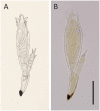Hesperomyces (Fungi, Ascomycota) associated with Hyperaspis ladybirds (Coleoptera, Coccinellidae): Rethinking host specificity
- PMID: 37746211
- PMCID: PMC10512334
- DOI: 10.3389/ffunb.2022.1040102
Hesperomyces (Fungi, Ascomycota) associated with Hyperaspis ladybirds (Coleoptera, Coccinellidae): Rethinking host specificity
Abstract
Laboulbeniales (Ascomycota, Laboulbeniomycetes) are biotrophic microfungi always attached to the exoskeleton of their arthropod hosts. They do not form hyphae or a mycelium; instead, they undergo determinate growth, developing from a two-celled ascospore to form a multicellular thallus. Hesperomyces virescens has been reported on over 30 species of ladybirds (Coleoptera, Coccinellidae); in reality, it represents a complex of species, presumably segregated by host genus association. In this study, we report on Hesperomyces thalli on Hyperaspis vinciguerrae from the Canary Islands and compare them with the Hesperomyces hyperaspidis described on Hyperaspis sp. from Trinidad. We generated the sequences of the internal transcribed spacer (ITS) region, the large subunit (LSU) nuclear ribosomal RNA gene, and the minichromosome maintenance complex component 7 (MCM7) protein-coding gene. Our phylogenetic reconstruction of Hesperomyces based on a concatenated ITS-LSU-MCM7 dataset revealed Hesperomyces sp. ex Hy. vinciguerrae as a member of the He. virescens species complex distinct from He. virescens sensu stricto (s.s.). It also revealed that the Hesperomyces sp. ex Chilocorus bipustulatus from Algeria is different from He. virescens s.s., which is associated with Chilocorus stigma from the USA. This suggests that the species of Hesperomyces are not solely segregated by host association, but that there is also a biogeographical component involved. Based on these data, we refrained from referring our material from Hy. vinciguerrae to He. hyperaspidis. Finally, we discuss the usefulness of MCM7 as a useful marker for species delimitation in Hesperomyces.
Keywords: Coccinellidae; DNA barcoding; MCM7; arthropod-associated fungi; integrative taxonomy; nuclear ribosomal DNA; phylogeny.
Copyright © 2023 Van Caenegem, Ceryngier, Romanowski, Pfister and Haelewaters.
Conflict of interest statement
The authors declare that the research was conducted in the absence of any commercial or financial relationships that could be construed as a potential conflict of interest.
Figures





References
-
- Abramoff M., Magalhães P., Ram S. J. (2004). Image processing with ImageJ. Biophotonics Int. 11, 36–42.
-
- Bernardi M., Barragán A., Rossi W. (2014). New records of Laboulbeniales (Fungi: Ascomycota) from Ecuador and other countries. Webbia 69, 281–289. doi: 10.1080/00837792.2014.953369 - DOI
-
- Bustamante D. E., Oliva M., Leiva S., Mendoza J. E., Bobadilla L., Angulo G., et al. (2019). Phylogeny and species delimitations in the entomopathogenic genus Beauveria (Hypocreales, Ascomycota), including the description of B. peruviensis sp. nov. MycoKeys 58, 47–68. doi: 10.3897/mycokeys.58.35764 - DOI - PMC - PubMed
LinkOut - more resources
Full Text Sources

